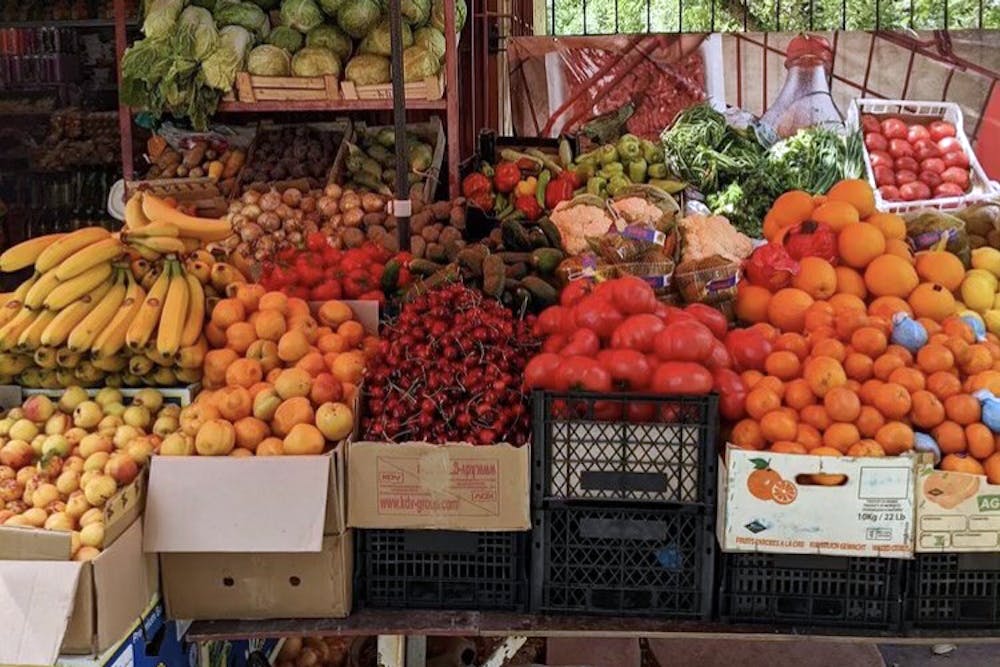Instagram feeds were inundated with sun-streaked photos from the Amalfi Coast of Italy and photo dumps from cobbled European lanes. It seems everyone studied abroad this summer — and they will not-so-subtly let you know it.
It's only natural for returning students to share the great memories they made as travelers. From navigating cultural differences in cooking to diving into new flavor profiles, food served allowed for students to learn about geopolitics, religion and diet for students abroad.

Restaurants can serve as theater, showcasing food as a part of culture. In Bishkek, Kyrgyzstan, a small central Asian chain called Navat became a frequent stop for Josh Hughes, third-year political science and Russian student. It was close to class and provided him with a traditional taste of Kyrgyz cuisine.
Navat's proximity and affordability made it a mainstay of Hughes's stay. Its focus on Kyrgyz national foods allowed him to discover a new favorite dish, Lagman.
Hughes likens Lagman to the typical Lo Mein, a noodle dish with vegetables and some sort of meat, but notes it is distinctly Uyghur in origin.
One difference to note, Hughes said, was how he was unable to participate in cooking with his host family. It is customary for women to cook in Kyrgyzstan.
"During the month of Ramadan, (the host family) obviously could not eat until the sun went down," Hughes said. "So, whenever (my host mom) was making a dish she would call me and I would like take like a sip of like the broth or they take a bite of the food and she'd want me to tell her, 'hey, is this missing, salt or some other ingredient?"
In Costa Rica, a host family acted as a culinary guide for Anaiah Kenas, a fourth-year public health student. Kenas said she enjoyed home-cooked meals from her host family for breakfast and dinner throughout her stay.
While rice and beans started off as something rather mundane to Kenas – it seemed like food of necessity, not specialty — Gallo Pinto, a ubiquitous Costa Rician dish, became a staple of Kenas' diet.
To Kenas, the seemingly inconspicuous Gallo Pinto was surprising because of its "incredible flavor."
Back across the Atlantic Ocean, host families played a large role in shaping the food of Elisa Carrillo’s, a fourth-year biochemistry student, time in Madrid, Spain.
Her personal favorite became the Spanish tortilla, which she said was more often enjoyed in the mornings and occasionally at dinner. The Spanish dish bares no resemblance to a Mexican tortilla, apart from the name –primarily composed of eggs, potatoes and onions, it can be modified like an omelet.
“But my personal favorite version had caramelized onions and goat cheese,” Carrillo said. “And then I'd have that with café con leche. It’s fantastic.”
She hasn't yet mastered making the dish at home, she said.
“I've tried once. I wasn't super successful, but I still have a lot of room to improve so I plan to continue working at it,” Carrillo said.
The truth is each country approaches food differently than our own. It can be hard to merge a new understanding of healthy eating habits and how they can fit into the standard American dietary system, especially when healthy food suffers from what Kenas describes as "an extreme lack of accessibility."
“(Gallo Pinto) helped me realize that just because you're fueling yourself with nutritious food doesn't mean it has to be bland, and it doesn't mean that it doesn't need to fill you up,” Kenas said.
A relatively simple dish led to Kenas' realization that food that is good for you can (and should) taste good.
“Being in America, a lot of the times I feel like I have to eat a lot to be full," Kenas said. "And by being there for a month, I realized we were eating smaller portions but I was fuller for longer."
According to Kenas, the contrast between the ways Americans and Costa Ricans engage with food and the broader food system may be one of convenience and access.
American stores and supermarkets are chock-full-of highly processed foods. These are the types of food someone would have to eat a lot of, as Kenas pointed out, to feel full.
Kenas will miss what she perceives to be a higher quality of ingredients.
While it is hard to find locally grown pineapple — something that Kenas enjoyed in Costa Rica — in the Continental U.S., there are ways to engage with locally grown foods here in Columbia, S.C. It just takes a little bit of effort.
There is a specific type of beauty in the culture that food creates. Everyone is an active participant in this sort of culture. You get to slice it, season it, reduce it and consume it any way you want to -- even if it is a complementary shot of fermented horse milk.

